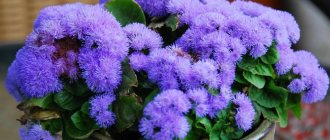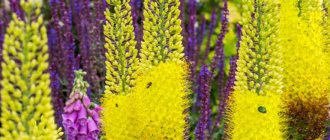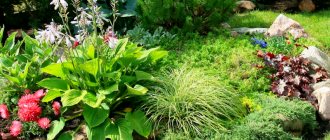Ageratum is a small, extremely attractive plant that grows naturally as a perennial. In our climate it is grown as an annual. Ageratum has small, colorful flowers in beautiful baskets and a subtle, pleasant aroma. It has a long flowering period and, thanks to its small size, will fit into any garden. Learn how to plant and care for ageratum in open ground.
General description of Mexican ageratum
Ageratum Mexicana is a herbaceous plant for open ground. In nature, it is considered a perennial species. In harsh climates, it has to be planted annually.
It is a lush bush with numerous shoots of a predominantly erect type, although varieties with climbing or creeping stems are also often found. Gardeners love to use them as ground covers. They grow quickly, and the stems, in contact with the soil, tend to germinate. As a result, instead of one shoot of ageratum, you get a beautiful carpet of fluffy inflorescences.
The height of the shoots of Mexican ageratum varies from 10 to 60 cm, depending on the variety. The stems are bluish-green in color due to their dense pubescence. The leaves are in most cases round or triangular. But in some varieties there are leaf blades of complex shape with a jagged edge. However, they are almost always dense, fleshy, slightly wrinkled. Color ranges from light green to deep green. The back side of the leaves is covered with grayish fibers.
The inflorescences of the Mexican ageratum are spherical, collected from 5-10 buds with long thin petals and many anthers tightly pressed to each other. Sizes and color depend on the variety. The diameter of the flowers themselves is small - about 3-5 cm. Depending on the variety, the inflorescences can reach 8-15 cm.
Predominant colors: all shades of pink, blue, purple. Currently, species with white, yellow and burgundy buds have been bred. By choosing the right varieties of Mexican ageratum, you can create a luxurious colored carpet in the garden.
Attention! Mexican ageratum has a strong, slightly sweet aroma. On summer days, the flower beds emit a pleasant smell that attracts insects, including bees. When growing ageratum on a plot, you can also count on increasing the yield of vegetable crops.
Ageratum Houston: varieties
Ageratum Houstona is available in many attractive varieties, such as:
Blaue Donau
- blue flowers
- compact growth
- height from 15 cm to 20 cm
Blue Horizon
- blue flower color
- height up to 70 cm
- flowering period from June to September
Basso Purple
- purple flowers
- especially the early variety
- flowering period from April to September
- height up to 45 cm
Alto Delft
- color purple
- height up to 35 cm
- good for flower boxes
- flowering period from May to September
Bicolor
- rare variety
- two-color: white and blue
- height from 15 cm to 20 cm
- good for containers
Capri
- blue flowers
- height from 15 cm to 20 cm
- beautiful as a border or in a container
- flowering period from June to October
Atlantic
- ultramarine color
- growth height up to 20 cm
- compact growth
- flowering period from May to September
Blue Eyes
- dark blue flowers
- compact height up to 20 cm
- works well outdoors
- flowering period from May to October
Old Gray
- gray-blue flowers
- height up to 50 cm
- rare variety
- flowering time from June to September
All varieties of Ageratum Houston not only create a dense carpet of flowers and grow well in flower boxes and pots, but also perfectly complement each other with flowers of different colors. Large varieties serve as a creative design element when planted against a backdrop of small-flowering perennials. The Houston Ageratum is so versatile that gardeners can give free rein to their imagination and reinvent a unique planting every year.
Share this article
Reproduction
Mexican ageratum is propagated by seeds and cuttings. According to biologists, many varieties reproduce by self-sowing. However, in the middle zone, seedlings most often die during night frosts.
The most popular propagation among gardeners is the propagation of Mexican ageratum by seeds. Moreover, the seed can be collected independently in the fall. But it is worth purchasing new seeds periodically. Otherwise, the plant may lose its varietal characteristics.
Interesting fact! There is another way. In autumn, the plant is transplanted into a flowerpot. At the beginning of spring, cuttings are cut from the shoots and placed in a glass of water. After the roots appear, they are planted in flowerpots or containers.
In May, an almost adult plant is planted in a flowerbed. It is important to have a well-lit place to grow the flower.
How to grow ageratum
Growing ageratum is a simple process and any amateur gardener can do it, the main thing is to follow the instructions below.
Planting seeds
To properly decorate the area near your house, it is enough to plant an exotic ageratum plant, but before breeding you should carefully study how to properly plant seeds in the ground. It is better to grow a flower crop from seed material, and at the initial stage of propagation, sowing is carried out from the middle to the last days of the first month of spring.
Sowing ageratum seeds
For the process, containers of shallow depth are used, which are filled with soil mixture. The substrate must contain a small amount of sand, organic matter, and peat. Before sowing, the soil is well moistened. The grains of the plant are very small, so they are scattered randomly, after which they are sprinkled with a thin layer of soil.
The box with plantings is covered with microclimate-preserving material and put away in a warm place. Crops require daily ventilation and periodic moistening. For this purpose it is very convenient to use a small special sprayer. After the seedlings appear two weeks later, the covering material is removed.
Growing ageratum from seeds at home is not difficult, the main rule is to comply with all the few requirements. When the seedlings have become stronger and have produced two true leaves, they are planted in another, more spacious container. Ageratum seedlings are planted in two stages.
Repeated diving is carried out after a few weeks. The grown, strong sprouts are planted in individual cups. Keep the plantings in a dry, warm room; the soil is periodically moistened. They do this only in the morning. Before planting ageratum in the ground, the seedlings are hardened off.
Planting ageratum seedlings in open ground
When the threat of late frosts has passed, they begin planting ageratum in open ground. Choose a place that is as bright as possible without exposure to drafts. In the area where the exotic plant will grow, the sun's rays should be present throughout the day. Lack of lighting leads to elongation of the stems, causing sparse flowering.
Planting ageratum in open ground
The soil is prepared light, slightly acidic with plenty of drainage and nutrients. The holes are made shallow, at a distance of ten to fifteen centimeters. Determine the depth at which the seedlings developed and plant at the same level. Properly planted plants begin to bloom in the second decade of June.
Application in design
The variety of varieties of Mexican ageratum is widely used in landscape design. They look great in both single and group plantings. In the garden, they are used to decorate borders, ridges, and alpine slides. They will be excellent neighbors for tall lilies or gladioli. Shade-tolerant varieties will cover the roots of rose bushes or clematis.
Mexican ageratum with creeping stems is perfect for decorating a large space. Dwarf varieties are grown in flowerpots and flowerpots on balconies, loggias or terraces.
Ageratum Houston: use
Low and compact varieties of Ageratum Houston are popular for edging flower beds, on graves and in balcony boxes.
This ornamental plant is used to fill gaps between various perennials and as a floral carpet in an open bed with marigolds, bluebells, antirrhinum and nemophila.
Tall varieties are suitable for group planting or for background decoration. They also make good cut flowers for a vase.
When combined with marigolds, marigolds, calceolaria, verbena, coreopsis, rudbeckia and heliopsis, the blue-violet flowers show off in all their glory.
Planting Mexican ageratum
There is one significant drawback to growing Mexican ageratum in blue or any other color. To get a beautiful flower bed at the beginning of summer, you will have to tinker with the seedlings in the spring. Otherwise, there is a high chance of waiting until flowering until August or losing young plants during return frosts.
When growing Ageratum Mexicana from seeds, it is customary to plant them in the first half of March. In regions with warmer climates, the dates are shifted to the end of February.
- As the soil, choose a purchased or self-prepared mixture of equal parts of garden soil, peat and sand.
- The soil must be disinfected by spilling it with a hot solution of bright pink potassium permanganate.
- Seeds can be placed in the refrigerator for a couple of weeks to harden and speed up germination. They should not be soaked or germinated.
- It is convenient to use mini-greenhouses as containers. However, small containers with drainage holes will do.
- The containers are filled with well-moistened soil and compacted thoroughly.
- Mexican ageratum seeds are mixed with sand and sown on the surface. Some gardeners practice sowing in snow.
- Mulch the top with dry peat, moisten it with a spray bottle and, covering the containers with film, place them in a dark and warm place.
Preparation of planting material and propagation
Ageratum (planting and care, photos will help gardeners prepare planting material for propagation and planting in open ground) is grown by seedlings and seeds. The first method is considered faster compared to the second.
To plant seedlings, use soil from special stores intended for terrace or hanging plants. To prepare the substrate yourself, you need to mix the humus with soil.
When planting seedlings in spring, you should adhere to the following points:
- Seeds must be sown from February to April. You will need to pour the soil into a box, make grooves 1 cm deep in it and distribute the planting material evenly.
- After filling the seeds with soil, the boxes need to be covered with glass or film to create a greenhouse effect, retain moisture and increase the temperature inside the container. For full plant growth, it is necessary to keep the temperature at least 20 ℃. Shoots will appear after 2 weeks.
- Picking of seedlings must be done after 4 full-fledged leaves appear on the plant. Then the seedlings should be planted in separate containers and watered abundantly.
- Young flowers should be planted during the warm period at an air temperature of at least 20 ℃ at a distance of 20 cm from each other.
Cultivating a flower by cuttings has its own characteristics. During the first frost, the flowers are transplanted into household containers and brought into the house.
Flower propagation by cuttings is described in the following paragraphs:
- Cuttings should be cut in March. For good moisture absorption, the cut must be made oblique.
- Afterwards, the cuttings need to be placed for a short period of time in a solution that stimulates growth (for example, “Kornevin”).
- Next, the cuttings should be sent to separate containers and greenhouse conditions should be created for them by covering the containers with film or glass. The soil must be kept moist and the temperature within 22 ℃.
- After 2 weeks, the cuttings will root.
The young plant will need to be moved into the ground to a sunny area after the arrival of consistently warm weather.
Rules for caring for Mexican ageratum
Plant care consists of:
- watering from 1 time per week in normal years, up to 3 times when hot and dry weather sets in;
- in fertilizing with liquid complex fertilizers;
- in weeding and loosening the soil.
Attention! To extend the flowering period, experienced gardeners recommend trimming faded inflorescences and removing dried shoots. Thus, the plant receives an incentive to form new flower stalks.
Planting Mexican ageratum and caring for it are simple. The only annoying thing is growing seedlings.
Home care
Obtaining abundant, long-lasting flowering of Ageratum is associated with following certain recommendations. Following simple rules will ensure the growth and flowering of the plant for 4-6 years.
Choosing a location and lighting
Ageratum needs intense lighting. Some shade is allowed, but the plant does not grow well in full shade. Plants grown in the shade are characterized by thin, elongated shoots that are prone to kinking and infection.
The optimal place to install the pot is the south side. Cold drafts are detrimental to shrubs. Therefore, you should carefully monitor the temperature.
Soil selection
The mechanochemical composition of the soil must include good drainage. Stagnation of water in the pot leads to the spread of rot and death of the plant. An acidic soil reaction is unacceptable. With increased acidity, the root system will be injured and become susceptible to infection.
The main condition for abundant flowering is the use of light, depleted soils. The use of nutrient soils slows down the flowering process.
Temperature and humidity
Ageratum grows well in the temperature range of +18-25 degrees. Being a heat-loving plant, it does not tolerate frost well. When the temperature drops below +18, the process of withering begins.
Ageratum is undemanding in terms of humidity. Regular room air is fine. But when the heating season begins, plants will need to be sprayed every 3-4 days.
Proper watering
Watering is carried out with warm, settled water. Using cold water inhibits root activity. Young plants need regular watering as the top 2 cm of soil dries out. Mature plants can tolerate short-term drought. However, long dry periods lead to reduced flowering.
Watering should be done in the morning, while trying not to get water on the leaves. After each watering it is necessary to loosen the soil.
Trimming
It is necessary to regularly remove faded inflorescences to maintain decorativeness. Removing broken and weak shoots leads to longer flowering and an increase in the number of inflorescences. Haircut has a stimulating effect on plant growth. To create a lush crown, pinching of young shoots is required. The method allows you to obtain additional branching and the formation of flower buds.
Faded inflorescences must be removed
Fertilizer application
Fertilizers are required to obtain abundant flowering. Complex fertilizers for flowering plants are suitable. They need to be applied every 14-21 days. The use of concentrated or organic fertilizers is prohibited.
When using nitrogenous fertilizers, it is recommended to apply a lower dosage, since excess leads to the growth of green mass and delays flowering.
Potassium-phosphorus supplements are required to stimulate budding.
Bloom
Ageratum blooms for several months, so one bush will have wilted and blossoming inflorescences. Dead flowers must be cut off if they are not planned to be used for seed production. Otherwise, leaving dried flowers will spoil the decorative appearance.
To obtain rich flowering, a sufficient level of light is required. In the shade, flowering is rare or completely absent. The plant blooms poorly in heavy soil. Therefore, you should maintain the soil in a loose state, monitoring the level of moisture.
Transfer
Replanting is required when the roots fill the volume of the pot or the plant is damaged by pests. 2 methods are used:
- Handling while preserving the earthen clod is for transferring a healthy plant.
- Cleaning the roots - for transporting a sick or pest-infested specimen.
Diseases and pests
Mexican ageratum rarely gets sick and only if the rules of agricultural technology are not followed. The main reason for the development of root rot or bacterial wilt is waterlogging of the soil and thickening of plantings. It is better to dig up and destroy affected plants.
You should not plant Mexican ageratums near cucumber ridges. They have a common pest - spider mites. In addition, aphids and whiteflies are not averse to eating the fleshy leaves. Chemicals are used to combat them.
Growing
Ageratum is relatively undemanding and can be grown by beginning gardeners. The most important thing is to provide a suitable landing site.
Requirements for soil and planting site
Longiflorum grows well in any type of soil. Prefers humus, fertile, constantly moist, but permeable soils. The preferred soil pH is 6.5. The plant adapts to most soil types. However, heavy soils and those that are too light should be mixed with compost to produce flowering mats. This is especially necessary on soils that are too light, since adding humus will allow the soil to better retain moisture.
Ageratum is a sun-loving plant. The flower should be placed in a sunny place, protected from gusts of wind. In a semi-shaded place, the plant grows weaker and blooms less. This delicate plant is sensitive to external factors; in our conditions, it cannot survive in winter in open ground. One cold day and the flower will die.
Care
- Mexican ageratum grows quickly and blooms profusely when fed with complex fertilizer for flowering plants - 2-3 times per season. However, on rich soils, spring fertilization is sufficient.
- The plant requires systematic, moderate watering and does not tolerate drought or lack of moisture in the substrate.
- An additional measure to help the plant grow better is to regularly remove dried leaves and inflorescences. Do not break them, but cut them with a sharp knife.
- After flowering, you can collect the seeds and store them in a cool place.
Diseases and pests
Ageratum is susceptible to the following diseases:
- Excess moisture can cause bacterial wilting of seedlings and shoots;
- gray mold;
- mosaic disease.
It is important to maintain optimal humidity to prevent the development of diseases. Pots should be placed in a ventilated, sunny place. Moisture and stagnant air encourage the growth of harmful fungi and mold on the ground.
Ageratum is sometimes attacked by pests:
- spider mite,
- nematodes,
- whitefly,
- earwigs.
When pests appear, it is necessary to spray the plant with special preparations - insecticides or acaricides. However, due to the very dense canopy, sometimes chemical control is not effective, so it is best to keep the soil moist so there is a chance that spider mites will not cause more damage.
Collecting seeds for planting
To obtain seeds for planting, flowers must be pollinated by bumblebees or bees. After the end of the flowering period of the plants, after approximately 2-3 weeks from the appearance of flowers, seeds are collected for future planting. The collected seeds are light brown in color, very light, have an elongated shape and small size. 1 gram can contain from 6 to 7 thousand pieces.
Seeds are best stored in paper or fabric bags in a cool, dry place.
Further care
First shoots
In order for the seeds to germinate faster, it is recommended to move the containers to a well-lit place with a temperature of +22°C. As a rule, shoots appear in 7–10 days. During this time, you will need to periodically remove the cover and moisten the soil with a spray bottle.
Sprouts need to be provided with regular moderate watering. It is necessary to moisten the soil with standing running water or rainwater. It should be at room temperature. After watering, the soil should be loosened using a toothpick or match. In order to prevent the development of black leg, it is recommended to water the seedlings with a solution of potassium permanganate 2 times during the growing period. 10 days after the sprouts appear, they need to be fed with mineral fertilizer with a minimum nitrogen content.
As soon as the plants have at least 4 true leaves, the seedlings need to be planted in peat pots or 400 ml glasses. A week after transplantation, ageratums must be fed with Agricola or Fertica.
2 weeks before transplanting plants into open ground, they need to begin to be hardened by briefly moving the glasses to fresh air. You should plan to plant ageratums only when the night temperature stops falling below +7°C. The place should be well lit. The area must be cleared of weeds in advance and dug up, adding complex mineral fertilizer for flowers. Instead of fertilizing, you can use compost (7 kg per 1 m²) and wood ash (2 cups per 1 m²).
It is recommended to plant ageratums in open ground in the evening or in cloudy weather. Recommended distance between bushes: 15–25 cm. Planted plants should be watered abundantly at the roots, and the surface of the soil should be mulched with tree bark.
Further care of the plantings involves watering as needed and timely removal of faded inflorescences. It is also recommended to feed ageratums with complex flower fertilizer 3 weeks after planting.
Miniature varieties of this ornamental plant will be an excellent decoration for borders, and tall specimens are perfect for further cutting. Ageratums can be combined with other flowers, and varieties with blue flowers look good in an arrangement with marigolds and zinnias.
How to plant ageratum with seeds
Propagation by seeds is a common method for ageratum, although the vegetative method (propagation by cuttings) is also suitable for it. In greenhouse conditions, this is how the crop is propagated. At home, they practice growing ageratum from seeds.
To obtain seedlings, it is necessary to prepare the soil substrate. You can buy soil at a garden store ("Universal" or "For Tomatoes" will do) or prepare the mixture yourself.
For the substrate take:
- high-rise crumbly peat – 1 part;
- soil taken from under an oak or linden tree – 1 part;
- fatty humus – 1 part;
- coarse river sand or vermiculite – 1 part.
All ingredients must be disinfected: steamed for half an hour in a water bath or poured with a hot raspberry solution of potassium permanganate. This procedure is necessary to rid the substrate of fungi and other pathogens.
Complete mineral fertilizer for flowers is added to the cooled soil, 1 matchbox per 5 liters of soil.
The finished soil is laid out in boxes, cassettes or individual pots.
How to plant ageratum seedlings:
- Flower seeds collected independently from their own plants are disinfected for half an hour in a Fitosporin solution before sowing.
- The seeds, dried until they flow, are laid out in seedling containers according to the following scheme: the distance between rows is 2-3 cm, the gap between seeds in a row is 1 cm. The sowing depth is no more than 5 mm.
- The crops are sprinkled with warm water and covered with glass or film. Before the seeds germinate, the bowls with ageratum should be kept in the light and warm (+22..25 degrees).
- Shoots will appear in 7-10 days. During this period, the boxes are periodically opened to ventilate and moisten the soil from the sprayer.
Ageratum sprouts are gradually accustomed to air by removing the film, first for a few minutes, then for several hours.











